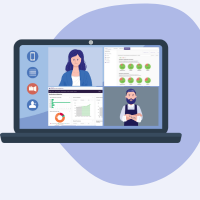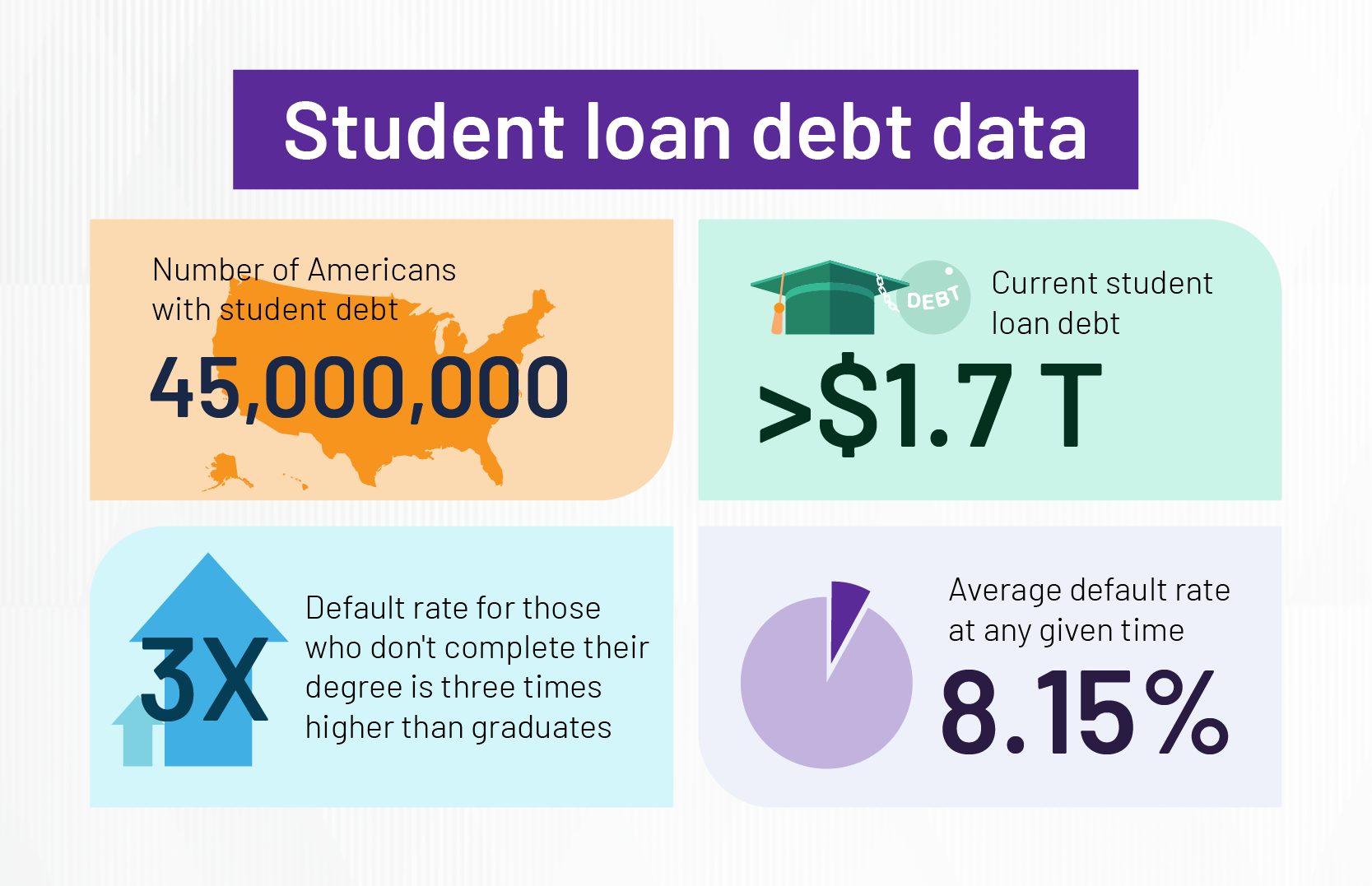
A student information system (SIS) plays a pivotal role in gathering and organizing student data. By harnessing the power of these tools, your higher education institution can gain a deeper understanding of its current processes and student performance.
SIS data is an invaluable tool for navigating continuous improvement efforts and providing students with the most advantageous educational experiences possible.
Colleges and universities can leverage SIS data to enhance their institutional processes and foster greater student success in many ways. We’re breaking down how your school can harness the powers of SIS data to supercharge your operations.
What are student information systems?
A student information system is a software solution designed to help higher education institutions manage their administrative and academic data. These platforms offer a centralized database for essential student-related information and insights.
An SIS helps streamline, automate, and simplify how your college or university:
- Handles its administrative tasks.
- Communicates with stakeholders.
- Supports student academic journeys.
These solutions are similar to a learning management system (LMS) but serve a slightly different purpose. While an LMS focuses on facilitating and managing course-specific data, an SIS’s primary intent is to manage student administrative data.
What is SIS data?
An SIS collects various types of data that educational institutions like yours can use to their advantage.
These platforms gather demographic data, including student names, addresses, birthdays, and contact details. Some store basic health and medical information. They also typically offer insight into enrollment status and admission applications, making pinpointing submission dates, program selection and acceptance or rejection statuses easy.
Student information system data also includes student academic records, such as:
- Completed courses.
- Grades.
- Credits earned.
- Class schedules.
- Degree requirements.
- Degree progress.
- Class attendance history.
- Standardized test scores.
Colleges and universities can utilize an SIS for student financial information about tuition payments, financial aid, and scholarships. These systems can track advisement interactions, including when students participate in career counseling or meet up with their academic mentors.
A student information system can also track student communications, including interactions with the institution. With so much data available through an SIS system, it is easy to see how these platforms offer so much value to your college or university.
Key benefits of using SIS data
Higher education institutions can reap many benefits from utilizing SIS data. In fact, experts project a 14.9 percent compound annual growth rate from 2022 to 2027 because of the impressive data management capabilities of these solutions.
Learn more about the benefits of SIS data below:
- Data-driven decision-making: Colleges and universities can use SIS insights to make informed decisions to optimize important institutional processes.
- Improved student support: SIS data also provides extensive insights into student experiences, allowing higher education institutions to inform their support services and ensure learners have the resources necessary to thrive.
- Enhanced academic planning: Institutions can reference SIS data to identify trends and opportunities for improvement in various academic processes, including course scheduling, enrollment, and planning.
- Personalized learning experiences: Student information systems store insights about student progress and academic histories. These factors help institutions create more tailored and personalized learning experiences backed by data.
- Streamlined administrative processes: A top benefit of utilizing SIS data for colleges and universities is reducing manual operations and automating daily processes to save time, money, and resources.
- Superior communication: Another key advantage of using the insights from an SIS to enhance communications, prompting greater engagement and collaboration across campus.
- Optimized continuous improvement: Student information data helps higher education institutions foster a culture of continuous improvement to support long-term success.
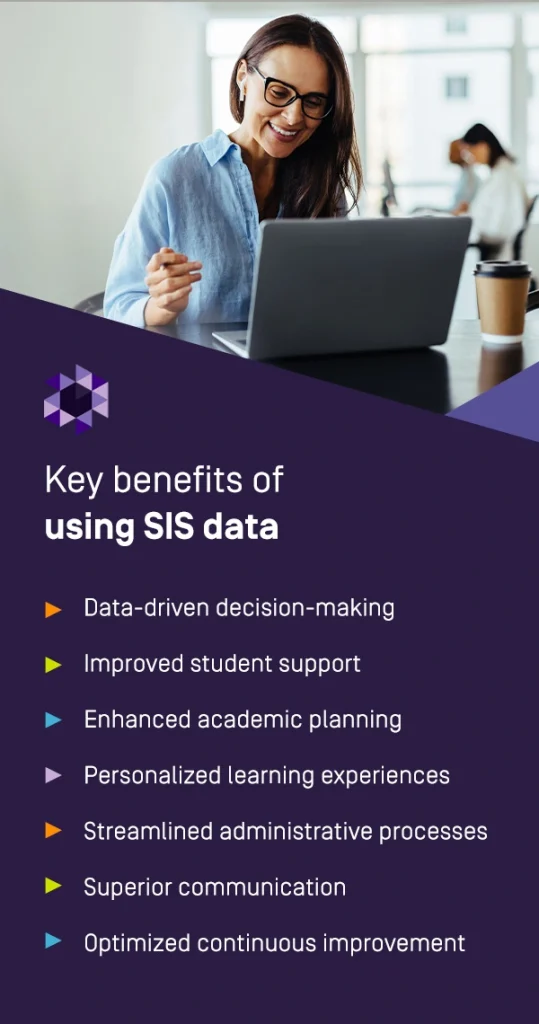
SIS helps colleges and universities track student progress and experiences to deliver optimal learning outcomes and experiences.
12 ways to take advantage of SIS data at your school
Colleges and universities can utilize SIS data to improve different aspects of their institutional operations.
Explore how your school can take advantage of student insights:
1. Admissions and enrollment
Higher education institutions can leverage SIS data to enhance their admissions processes in a few ways. With data analytics, your college or university can explore historical data to identify important enrollment trends and the primary factors contributing to successful admissions. Schools can also use this data to enhance how they manage and track the applicants while reducing administrative burdens.
SIS data can also be a driving force in your institution’s marketing and recruitment efforts. The extensive demographic information stored on these systems offers valuable insight into common characteristics of thriving students, such as their academic priorities, interests, and preferences. Schools can more easily target marketing campaigns and efforts to the right individuals with this information. SIS data also supports accurate enrollment forecasting for improved future planning.
2. Academic advising
SIS data can supercharge your higher education institution’s academic advising processes. These insights provide advisors with a more comprehensive look into student progress and performance.
Analyzing factors, including grades, attendance, and courses completed, can help academic mentors accurately gauge the student’s history and leverage that information to provide tailored support and guidance. With SIS data, your institution’s advisors can improve efforts to keep learners on track to acquire their degrees in the expected timeframe.
With historical data about course enrollment, class capacities, and demand at their fingertips, your faculty and staff can act proactively. They can direct students as they select courses and create their schedules to ensure they get into their required classes with fewer conflicts and challenges.
3. Attendance tracking
Another way colleges and universities can take advantage of SIS data is by monitoring student attendance at classes, seminars, and other campus events. Attendance is closely linked with academic success, so this metric can be highly insightful and help institutions promptly flag at-risk students who don’t show up for class.
Attendance tracking is crucial in higher education for several reasons:
- Student engagement: An individual who frequently skips class or arrives late misses out on essential concepts, lessons, and instruction, barring them from actively engaging in their coursework and meeting important learning outcomes.
- Funding and compliance standards: Higher education institutions often have to report attendance data for federal and state funding programs, financial aid requirements, and accreditation planning.
- Career preparedness: Attendance and punctuality are critical elements of professionalism. Students who attend all of their classes are setting a foundation for success in the working world.
SIS data allows schools to identify attendance patterns, implement strategies to reduce absences, and recognize committed students who prioritize their classes.
4. Retention and intervention
Colleges and universities can also use student information system data to inform retention efforts. With insights into academic performance, attendance history, and engagement, institutions can more easily identify at-risk students who could benefit from early intervention and additional resources. Key warning signs may include dropping courses mid-semester or declining grades. Having systems in place to flag behaviors like these can help your institution provide much-needed support for struggling individuals before they drop out.
SIS data enables early intervention, allowing schools to improve student retention rates and help more individuals arrive at graduation day. Improving retention and fostering better graduation rates is simple with the help of a student information system. Plus, your institution can use its data to track the effectiveness of intervention strategies.
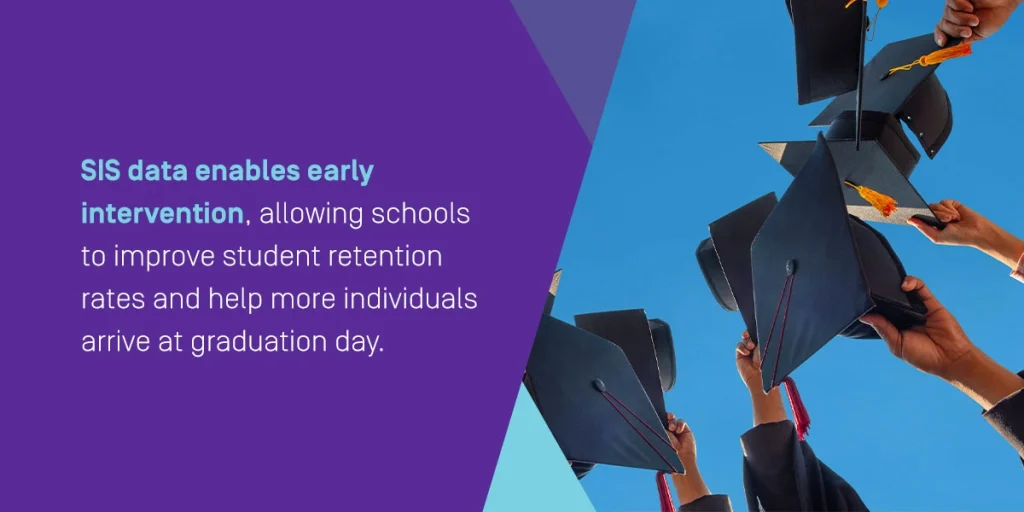
5. Meeting accreditation requirements
Your school can also leverage SIS data to support accreditation planning and success. Many accrediting bodies require higher education institutions to collect and report on student data, including:
- Enrollment numbers.
- Student demographics.
- Graduation rates.
- Retention rates.
You can utilize the data to demonstrate how your institution is actively meeting accreditation standards. By analyzing the insights from an SIS, such as student feedback and course completion, schools can identify opportunities for improvement regarding specific courses, departments, and degree programs. Acting on these insights can help institutions align with accreditor requirements and adequately prepare for review.
Accreditation planning is simple with the help of SIS data. Ultimately, your institution can use your system to:
- Track student achievement.
- Facilitate plans for improvement.
- Provide evidence of compliance.
6. Financial planning and aid disbursement
Higher education institutions can utilize the data from their student information system to enhance financial aid processes. An SIS gathers useful information about students, including income levels, family backgrounds, and other demographic data that can help your college or university identify the individuals who could benefit most from financial aid.
Institutions can make data-driven decisions about where to allocate monetary resources and better support students who may have a financial disadvantage. SIS data can make it simple to see which students meet requirements for different types of aid, such as:
- Grants.
- Scholarships.
- Loans.
SIS insights also help colleges and universities analyze student debt levels and offer guidance for managing these payments now and in the future.
7. Course registration and scheduling
Student management software like an SIS can be a handy tool for improving course registration and scheduling for your higher education institution. These insights streamline demand analysis by providing historical enrollment data you can use to identify particularly popular courses. Your college and university can use this information to optimize class offerings, helping students get into their desired courses with less conflict and competition.
SIS data can also help institutions analyze enrollment patterns, assess the effectiveness of existing registration processes, and monitor student interest. Your school can use this data to boost its course timing, manage waitlists, and streamline scheduling protocols to deliver better learning experiences and meet more student needs.
8. Resource allocation
Your higher education institution can leverage SIS data to improve and inform resource allocation in a few different ways:
- Enrollment forecasting: Student information systems gather and store valuable insight into enrollment trends that help colleges and universities tailor decision-making to adequately anticipate student needs.
- Faculty and facility utilization: In analyzing SIS data, schools can more easily identify patterns in resource utilization relating to faculty, classrooms, class sizes, and other campus facilities to determine how to use these resources optimally.
- Budgeting: SIS data can inform financial planning and assist institutions in determining the best use of every dollar, whether it be for financial aid, investing in new educational resources, hiring additional faculty, or upgrading campus facilities.
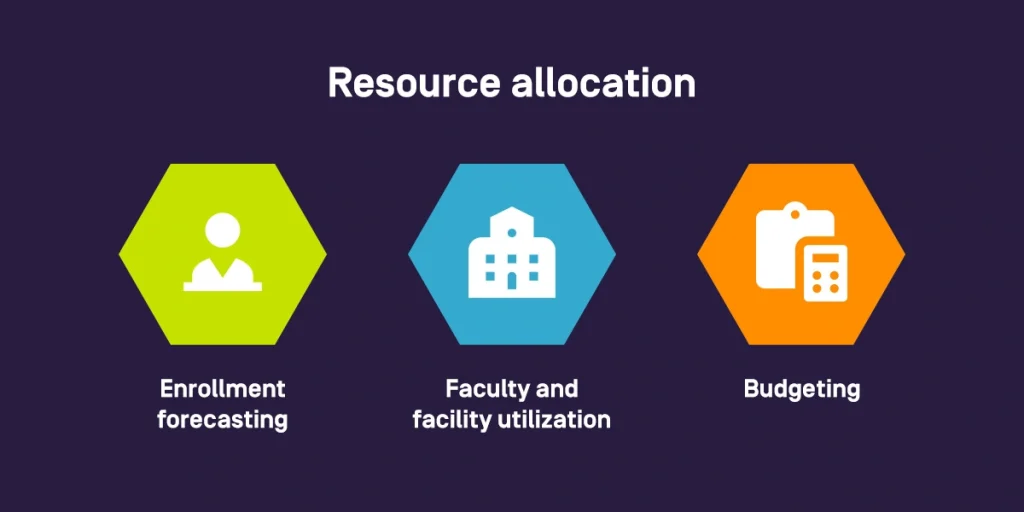
9. Curriculum improvement
Another way colleges and universities can take advantage of student information system data is by using it to inform curriculum development. An SIS can provide insight into student feedback via course evaluations, surveys, and questionnaires. Institutions can use this data to identify areas that need improvement and implement changes to better serve students.
SIS data also offers a look into student progress and course completion, which can help colleges or universities determine where the curriculum falls short and where it excels. You can utilize these insights to make large adjustments, like reworking a degree program, or smaller updates, like tailoring lesson plans to align with desired learning outcomes.
10. Transcript management
Universities and colleges can use SIS data to streamline transcript management at nearly every level. Because these tools house comprehensive student records, including academic standings, course completion, grades, and progress toward degree requirements, they are highly useful in automating the transcript generation process.
Higher education institutions can lessen the burdens and responsibilities of school administrators with the help of SIS data. When individuals need to share their transcripts with potential employers or graduate schools, the insights from an SIS can help boost the accuracy and overall efficiency of your management processes.
11. Institutional research
An SIS can provide colleges and universities with the data and insights needed to enhance institutional research and evaluation efforts.
Your school can use the information these systems collect and store to analyze various aspects of your institution, from enrollment rates to curriculum design to retention strategies. Ultimately, these insights will provide you with a foundation for gauging success.
As you review student data, your institution can establish benchmarks for achievement that you can utilize to gauge the effectiveness of your operations. Research is a key element of continuous improvement, and schools can benefit from exploring SIS data to identify opportunities to refine their practices and support long-term growth.
12. Campus systems optimization
Your higher education institution can also use SIS data to inform other important campus solutions, such as data management software or a learning management system.
Integrating SIS data with other systems can help colleges and universities get more out of these tools. Your student information can work with reporting and analytics platforms to consolidate insights about your essential processes into easy-to-understand reports that you can use for compliance and accreditation planning.
SIS data also allows institutions like yours to take a data-driven approach to optimizing your campus systems, helping you to streamline workflows and ultimately offer better support to your students.
Request a demo of higher education software from Watermark today
A student information system provides you with extensive features and benefits, and the higher education solutions from Watermark can help you maximize its benefits. Our systems communicate with SIS platforms and make it easy to collect, share, and report on student data, including test scores, transcripts, demographics, and much more.
Watermark helps colleges and universities like yours spend less time gathering data and more time acting on it to enhance your operations and provide better student experiences.
Interested in learning more? Request a demo of higher education software from Watermark to get started today.



